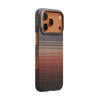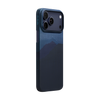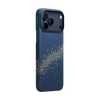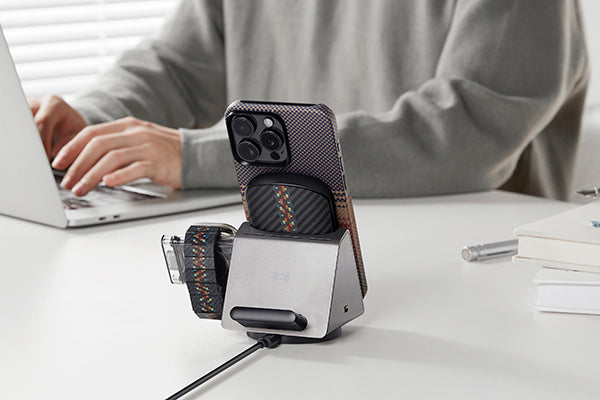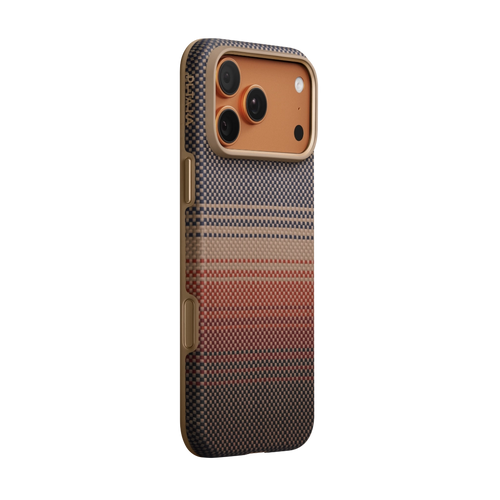Aramid fiber and carbon fiber have different molecular structures and properties. Because of its remarkable impact resistance and flexibility, aramid fiber is ideal for protective gear and other applications that require toughness. In contrast, carbon fiber is well-suited for use in aerospace and high-performance automotive components due to its extreme rigidity and strength-to-weight ratio.
PITAKA is a leading brand that specializes in creating tech accessories using advanced materials such as aramid fiber.
Wondering about the difference between aramid and carbon fiber? We explore the characteristics of each and how we’ve combined the best of both below.
Properties and Characteristics of Aramid Fiber and Carbon Fiber
|
Property
|
Aramid Fiber
|
|
|
Tensile Strength
|
· Resists stretching
· Absorbs impact without shattering
|
· Stronger than aramid, but more brittle
· Can snap with abrupt force
|
|
Strength-to-Weight Ratio (aka, specific strength)*
|
· Range from 550,000 to 820,000 ft
|
· ≈ 1,275,000 ft
|
|
Electrical Conductivity
|
· Non-conductive
· No interference with radio frequency
|
· Excellent electrical conductivity
· Can interfere with signal/radio frequency
|
|
Chemical Resistance
|
· Maintains structural integrity when exposed to chemicals
· Can perform well in unpredictable chemical environments
|
· Resistance varies depending on resin matrix encapsulating the fibers
· Can perform well in unpredictable chemical environments
|
|
Colors
|
· Golden-yellow color
· Color can vary, depending on manufacturing process
|
· Typically black or dark gray
Color can be changed when combined with aramid fiber
|
|
Cost
|
· High cost
|
· More expensive than aramid fiber
|
Applications of Aramid Fiber and Carbon Fiber
Applications of Aramid Fiber
Aramid fibers (such as the popular Kevlar) offer better resistance to impact, abrasion, and cutting. As a result, these synthetic fibers are used in a wide variety of impact-resistant products, including:
Bulletproof vests and ballistic body armor
Protective gear: For firefighters, industrial workers, and military personnel
Reinforcement materials, rope, cables, and conveyor belts
Sports equipment: Racing sails, hockey sticks, ski poles, and archery bows
Automotive parts: Tires, brake pads, clutches, and gaskets
Aerospace and marine applications: Skins of high-speed boats and aircraft
Applications of Carbon Fiber
In contrast, carbon fibers provide superior stiffness and thermal conductivity, which suits applications that require rigidity, such as:
Aerospace: Aircraft and space shuttle components
Automotive: Frames, body panels, and other components
Sporting goods: Bicycles, golf clubs, tennis rackets, and fishing rods
Wind energy: Wind turbine blades
Civil engineering and reinforcement: Concrete, retrofit buildings, bridges, pipelines, and repairs
Medical equipment: Prosthetic limbs, X-ray equipment, and other medical devices
Uses of Aramid Fiber and Carbon Fiber for Phone Cases
Why Aramid Fiber and Carbon Fiber Cases Are Preferred
High Strength-to-Weight Ratio
This excellent property ensures that the phone case can be durable enough to withstand daily wear and tear without adding unnecessary weight or bulk to the phone.
Aesthetics
Both aramid fiber and carbon fiber have a distinct textured color that is often associated with modern, high-end designs. This adds a sophisticated look to phone cases made from these materials.
Chemical Resistance
High resistance to chemical damage means that these phone cases can withstand exposure to natural body oils on hands, cosmetics, or other common chemicals they may come into contact with.
Comparison of Aramid Fiber and Carbon Fiber in Phone Cases
|
Feature
|
Aramid Fiber
|
Carbon Fiber
|
|
Impact Resistance
|
· Protects devices by absorbing impact
· Reduces likelihood of damage
|
· Can crack or shatter on impact
|
|
Signal Strength
|
· Does not block radio waves or radio frequency
· Ensures optimal device connectivity and performance
|
· Conductive properties can interfere with cell signals, Wi-Fi, or GPS
|
|
Aesthetics
|
· Attractive twilled or plain weaving patterns
· Can be dyed in various colors and patterns
· More design options
|
· Visually appealing
· Limited colors and designs
|
|
Cost
|
· More affordable than carbon fiber
|
· High-cost products
|
PITAKA Aramid Fiber Phone Case
Made from aramid fiber, PITAKA’s phone cases, including the iPhone 15 Pro Max cases and Samsung Galaxy S24 Ultra cases, are known for combining protection and functionality with stylish design.
Material and Design
Because it has a very high strength-to-weight ratio, aramid fiber provides very light and exceptionally durable cases. Our cases also have a slim profile that doesn't add much bulk to the phone. For instance, one of our iPhone 15 cases is 0.75 mm thin and weighs only 13 grams! Additionally, the textured finish enhances the phone's granular feel in hand, which can reduce the risk of slips and drops
Protection
Even though PITAKA's aramid fiber cases are thin, they are designed to offer significant protection against everyday accidents and scratches. Plus, PITAKA's phone cases have raised edges to protect the screen and camera lenses from contact with surfaces when placed face down.
MagSafe Compatibility
PITAKA has developed the innovative MagSafe Slimboard and Amber Magnet Film technologies to embed the MagSafe magnets into the slim and light aramid fiber phone case. This ingenious feature makes it easy to connect your phone to MagSafe accessories like wallets, grips, or car phone holders. You can even snap your device to a MagSafe charger to enjoy wireless charging without the hassle of removing the case.
Functionality
As we’ve mentioned, aramid fiber is non-conductive. So, you can rest assured that our aramid fiber phone cases will not interfere with your phone's signal.
Aesthetics
PITAKA's aramid fiber phone cases help maintain every device's sleekness. Through Fusion Weaving technology, an innovative weaving technique exclusively developed and owned by PITAKA, our aramid fiber cases can offer more stylish designs, like the Sunset Moonrise MagEZ Case for iPhone 15 Pro Max, Samsung Galaxy S24 Ultra, and more.
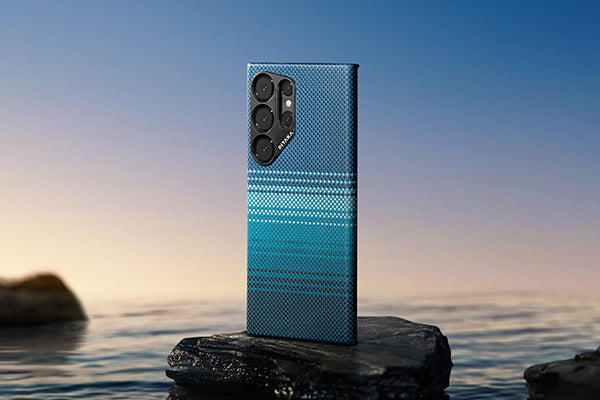
The Combination of Aramid Fiber and Carbon Fiber
By blending aramid and carbon fiber with technology, we can maximize both functionality and aesthetics. PITAKA's ChromaCarbon technology is the best example.
PITAKA is a pioneer in using carbon fiber to make watch bands. The low thermal conductivity of carbon fiber ensures that the bands can be worn comfortably in the hottest summer or the coldest winter. Its strength-to-weight ratio provides durability without adding weight, while the sleek black and gray texture adds a touch of elegance.
Through the development of ChromaCarbon technology, PITAKA has successfully combined aramid fiber with carbon fiber to create straps that are lightweight yet durable. Moreover, aramid fiber breaks through the color limitations of carbon fiber, which adds vibrancy to our watch bands, as seen in the Rhapsody, Dreamland, and Poetry of Things collections.
Aramid fiber and carbon fiber are used across many sectors because of their unique advantages. When it comes to mobile phone cases and wearable accessories, you’ll want a lightweight, cost-effective product with exceptional strength and impact resistance. Look no further!
Visit PITAKA's online store or authorized distributors to check out our diverse range of aramid fiber and carbon fiber cases for your phone, iPad, Apple Watch, AirPods, and other gadgets.
FAQs
How does PITAKA's Fusion Weaving technology enhance the design of aramid fiber phone cases?
PITAKA's Fusion Weaving technology enhances the design of aramid fiber phone cases by creating sophisticated patterns and designs that add a unique aesthetic appeal to the cases.
How does the combination of aramid fiber and carbon fiber in PITAKA's ChromaCarbon technology benefit watch bands?
PITAKA's ChromaCarbon technology combines aramid fiber and carbon fiber to create watch bands that are lightweight, durable, and visually appealing.



